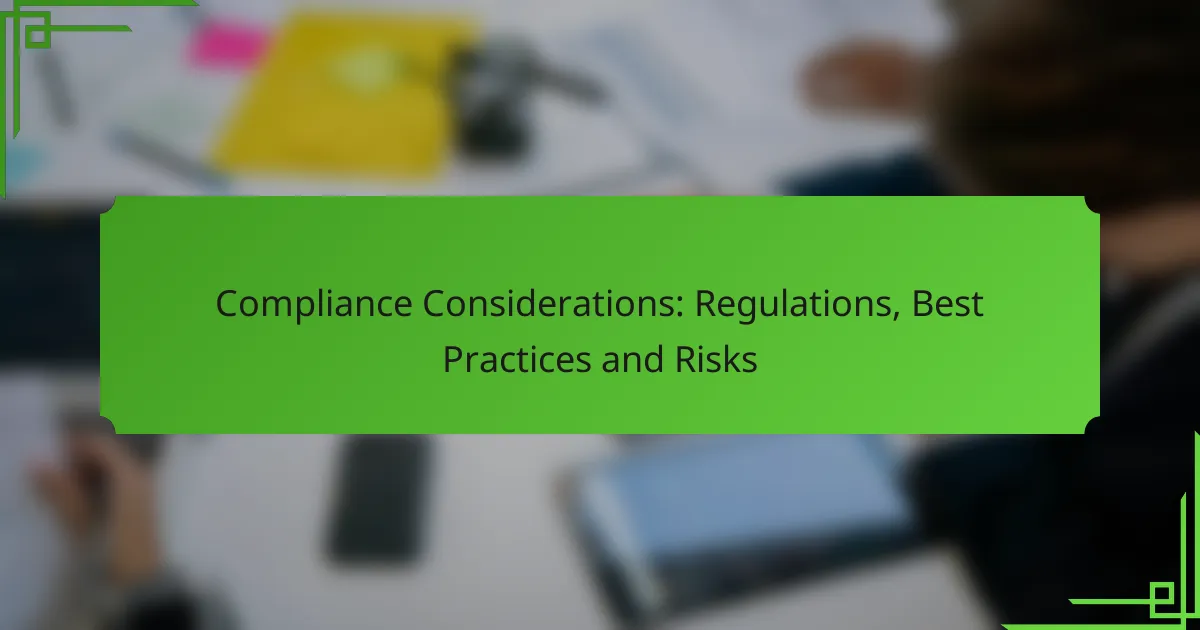Compliance considerations are crucial for organizations to navigate the complex landscape of regulations governing data protection, privacy, and security. By implementing robust systems and best practices, businesses can mitigate risks, avoid legal penalties, and ensure the protection of sensitive information. Establishing effective compliance management strategies, including regular audits and employee training, is essential for maintaining adherence to legal standards.
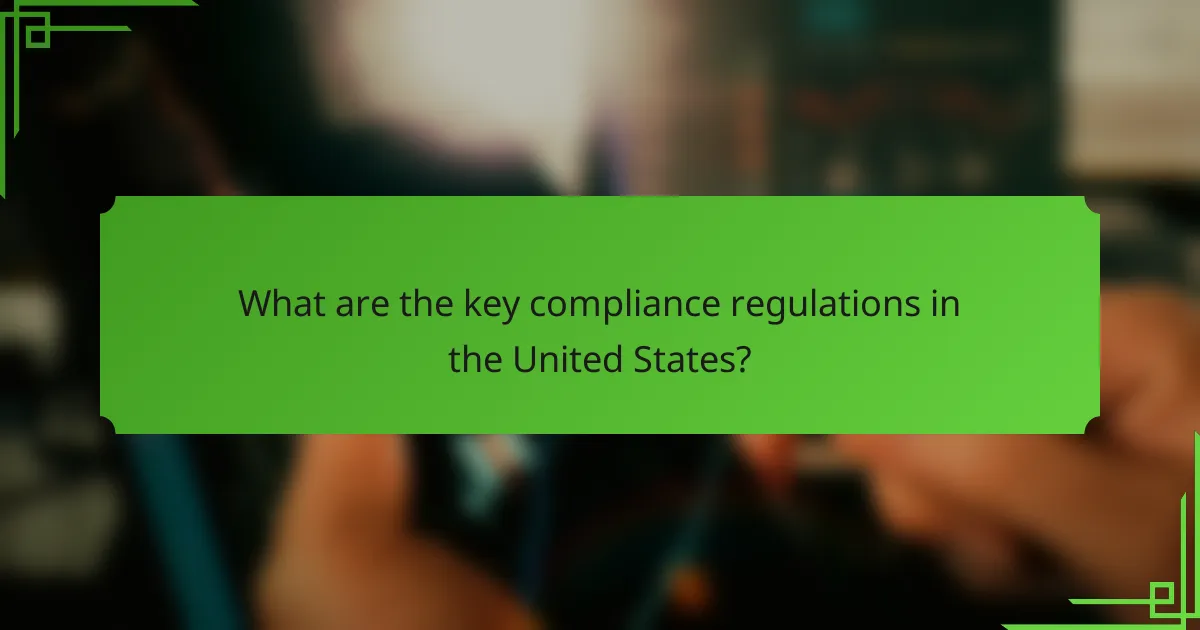
What are the key compliance regulations in the United States?
Key compliance regulations in the United States include laws that govern data protection, privacy, and security across various sectors. Organizations must adhere to these regulations to avoid legal penalties and ensure the protection of sensitive information.
Health Insurance Portability and Accountability Act (HIPAA)
HIPAA is a federal law that establishes national standards for the protection of health information. It mandates that healthcare providers, insurers, and their business associates implement safeguards to ensure the confidentiality and security of patient data.
Organizations must conduct risk assessments, implement security measures, and provide employee training to comply with HIPAA. Non-compliance can result in substantial fines, ranging from thousands to millions of dollars depending on the severity of the violation.
General Data Protection Regulation (GDPR)
Although GDPR is a European regulation, it affects U.S. companies that handle the personal data of EU residents. It emphasizes data protection and privacy, requiring organizations to obtain explicit consent from individuals before processing their data.
Compliance with GDPR involves implementing data protection measures, appointing a Data Protection Officer (DPO), and ensuring transparency in data processing activities. Fines for non-compliance can reach up to 4% of annual global revenue or €20 million, whichever is higher.
Federal Information Security Management Act (FISMA)
FISMA requires federal agencies and their contractors to secure information systems against threats and vulnerabilities. It mandates the development of information security programs that include risk assessments and continuous monitoring.
Organizations must adhere to standards set by the National Institute of Standards and Technology (NIST) and regularly report on their security posture. Failure to comply with FISMA can lead to loss of federal contracts and funding, as well as increased scrutiny from regulatory bodies.
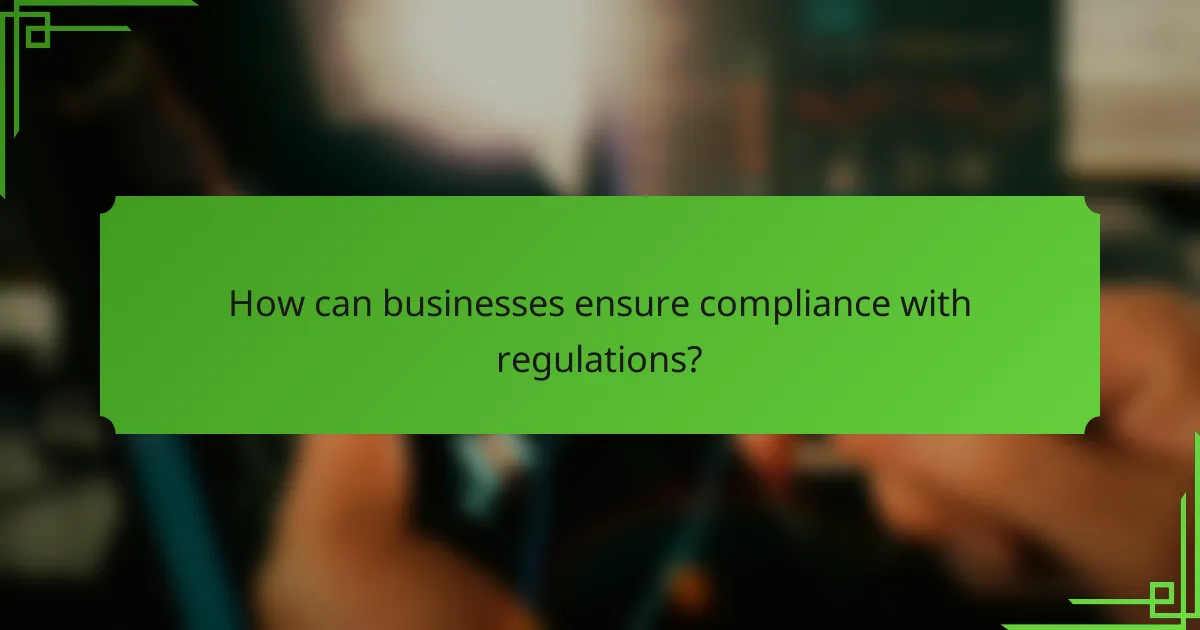
How can businesses ensure compliance with regulations?
Businesses can ensure compliance with regulations by establishing robust systems and practices that monitor adherence to legal standards. This involves implementing compliance management systems, conducting regular audits, and training employees effectively on compliance practices.
Implementing compliance management systems
Compliance management systems (CMS) are frameworks that help organizations manage and monitor compliance with regulations. A well-designed CMS typically includes policies, procedures, and tools that facilitate compliance tracking and reporting.
When implementing a CMS, businesses should consider industry-specific regulations and tailor their systems accordingly. For example, financial institutions may need to comply with regulations like the Sarbanes-Oxley Act or GDPR for data protection, which requires specific documentation and reporting processes.
Conducting regular audits
Regular audits are essential for assessing compliance with internal policies and external regulations. These audits can be conducted internally or by third-party firms to provide an objective evaluation of compliance practices.
Businesses should schedule audits at least annually, but more frequent audits may be necessary in high-risk industries. During audits, organizations should review documentation, interview staff, and assess compliance with established policies to identify areas for improvement.
Training employees on compliance practices
Training employees on compliance practices is crucial for fostering a culture of compliance within the organization. Regular training sessions should cover relevant regulations, company policies, and the consequences of non-compliance.
To maximize effectiveness, training should be tailored to different roles within the company. For instance, frontline staff may need training focused on customer data handling, while management might require insights into regulatory reporting obligations. Implementing a mix of online courses, workshops, and refresher sessions can enhance understanding and retention of compliance practices.
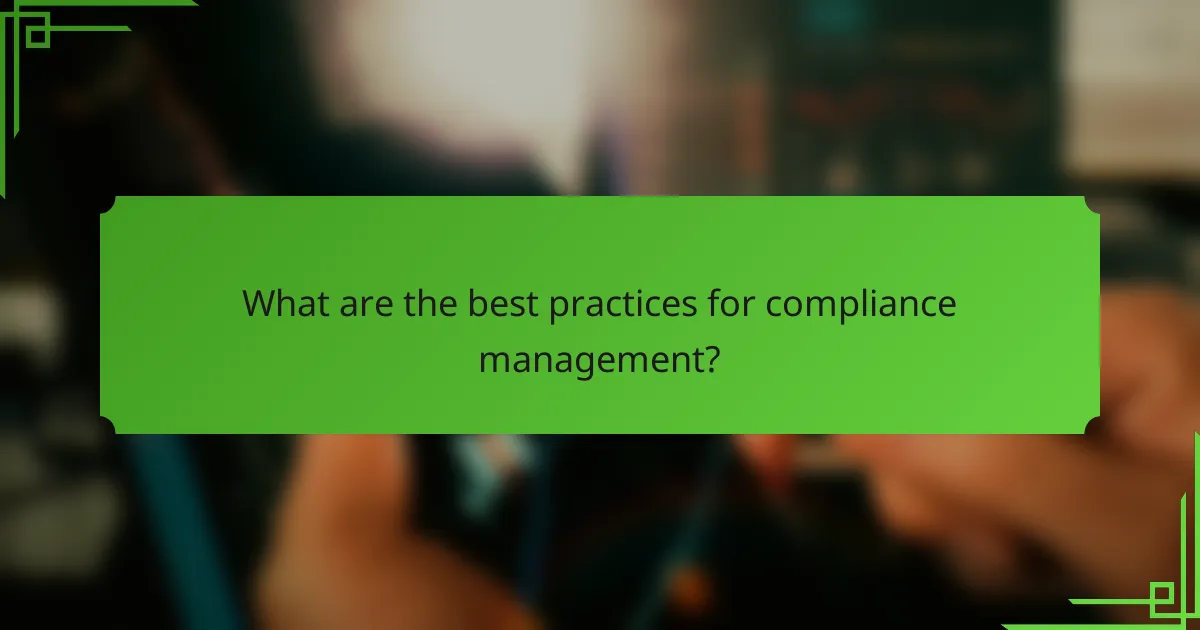
What are the best practices for compliance management?
The best practices for compliance management involve establishing robust policies, leveraging technology, and consulting with legal experts. These strategies help organizations navigate regulations effectively while minimizing risks and ensuring adherence to industry standards.
Establishing clear policies and procedures
Clear policies and procedures are foundational to effective compliance management. Organizations should document their compliance expectations, outlining specific roles and responsibilities for employees at all levels. This clarity helps prevent misunderstandings and ensures everyone is aware of their obligations.
Regularly reviewing and updating these policies is crucial, especially when regulations change or new risks emerge. Consider conducting annual audits to assess the effectiveness of your compliance policies and make adjustments as necessary.
Utilizing compliance software solutions
Compliance software solutions streamline the management of compliance tasks, making it easier to track obligations and deadlines. These tools often include features like automated reporting, risk assessment, and document management, which can significantly reduce the administrative burden on compliance teams.
When selecting compliance software, look for solutions that integrate well with existing systems and offer user-friendly interfaces. Popular options may include platforms that provide real-time monitoring and alerts for regulatory changes relevant to your industry.
Engaging with legal experts
Consulting with legal experts is essential for staying informed about regulatory requirements and best practices. Legal professionals can provide tailored advice based on your specific industry and operational context, helping to mitigate risks associated with non-compliance.
Establishing a relationship with legal counsel can also facilitate proactive compliance strategies. Regular consultations can help identify potential compliance issues before they escalate, ensuring your organization remains ahead of regulatory changes and industry standards.

What are the risks of non-compliance?
Non-compliance can lead to significant risks that affect an organization’s financial stability, reputation, and legal standing. Understanding these risks is crucial for businesses to mitigate potential damage and ensure adherence to regulations.
Financial penalties
Financial penalties are one of the most immediate consequences of non-compliance. Organizations may face fines that can range from hundreds to millions of dollars, depending on the severity of the violation and the regulatory body involved. For instance, data protection breaches under GDPR can result in fines up to 4% of annual global turnover.
To avoid financial penalties, companies should regularly audit their compliance processes and implement robust training programs for employees. Establishing a compliance budget can also help manage potential costs associated with non-compliance.
Reputational damage
Reputational damage can have long-lasting effects on a business following non-compliance incidents. Negative publicity can erode customer trust, leading to decreased sales and loss of market share. For example, companies involved in data breaches often experience a significant drop in customer loyalty.
To protect their reputation, organizations should proactively communicate their compliance efforts and respond transparently to any incidents. Engaging in corporate social responsibility initiatives can also help rebuild trust with stakeholders.
Legal consequences
Legal consequences of non-compliance can include lawsuits, sanctions, and even criminal charges against individuals within the organization. Regulatory bodies may take legal action to enforce compliance, which can lead to costly litigation and settlements. For example, companies found guilty of violating environmental regulations may face both fines and legal action from affected communities.
To mitigate legal risks, businesses should stay informed about relevant laws and regulations, conduct regular compliance training, and consult legal experts when necessary. Implementing a compliance management system can also help track adherence to legal requirements and reduce the likelihood of violations.
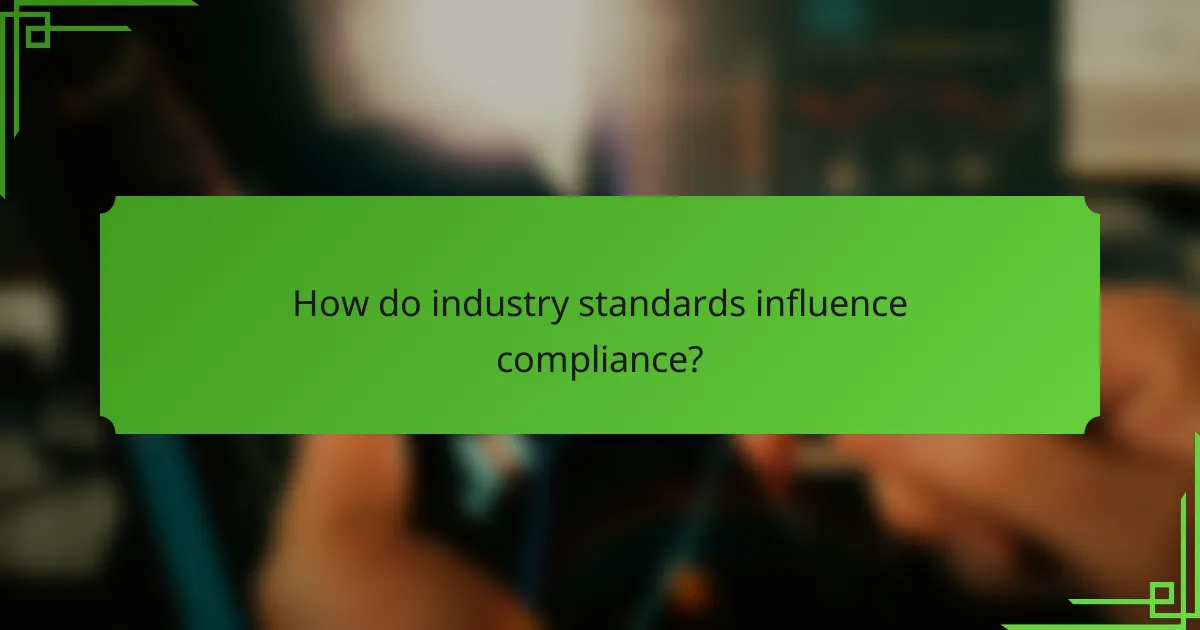
How do industry standards influence compliance?
Industry standards play a crucial role in shaping compliance by providing frameworks and guidelines that organizations can follow to meet legal and regulatory requirements. Adhering to these standards helps businesses mitigate risks, enhance security, and build trust with stakeholders.
ISO 27001 for information security
ISO 27001 is an international standard that outlines the requirements for establishing, implementing, maintaining, and continually improving an information security management system (ISMS). Organizations that comply with ISO 27001 can effectively manage sensitive information, ensuring its confidentiality, integrity, and availability.
To achieve ISO 27001 certification, organizations should assess their current security posture, identify risks, and implement appropriate controls. Regular audits and continuous improvement processes are essential to maintain compliance and adapt to evolving threats.
NIST Cybersecurity Framework
The NIST Cybersecurity Framework provides a policy framework of computer security guidance for how private sector organizations can assess and improve their ability to prevent, detect, and respond to cyber attacks. It consists of five core functions: Identify, Protect, Detect, Respond, and Recover.
Organizations can implement the NIST framework by conducting a risk assessment, developing a cybersecurity policy, and establishing incident response plans. Regular training and awareness programs for employees are also critical to ensure that everyone understands their role in maintaining cybersecurity compliance.

What role does technology play in compliance?
Technology plays a crucial role in compliance by automating processes, enhancing data accuracy, and facilitating real-time monitoring. It helps organizations adhere to regulations and best practices while minimizing risks associated with non-compliance.
Automation of Compliance Processes
Automation streamlines compliance tasks, reducing the manual workload and the potential for human error. For instance, software solutions can automatically generate compliance reports, track regulatory changes, and ensure that all necessary documentation is up to date.
Implementing automated systems can lead to significant time savings, allowing compliance teams to focus on strategic initiatives rather than routine tasks. Organizations often find that automation can cut compliance costs by a notable percentage, making it a worthwhile investment.
Data Management and Security
Effective data management is essential for compliance, especially regarding sensitive information. Technology enables organizations to securely store, process, and analyze data while adhering to regulations such as GDPR or HIPAA.
Using encryption, access controls, and regular audits can help protect data integrity and confidentiality. Organizations should consider adopting data management platforms that offer compliance features to ensure they meet legal requirements and mitigate risks.
Real-Time Monitoring and Reporting
Real-time monitoring tools provide organizations with immediate insights into compliance status and potential issues. These tools can alert teams to anomalies or breaches, allowing for swift corrective actions.
Regular reporting through dashboards and analytics can help stakeholders understand compliance performance. Organizations should establish a routine for reviewing these reports to identify trends and areas for improvement.
Training and Awareness
Technology also facilitates training and awareness programs for employees regarding compliance requirements. Online training modules and interactive platforms can enhance understanding and engagement.
Regular training sessions, supplemented by technology, can help ensure that employees are aware of their responsibilities and the importance of compliance. Organizations should track participation and effectiveness to continually improve their training efforts.
